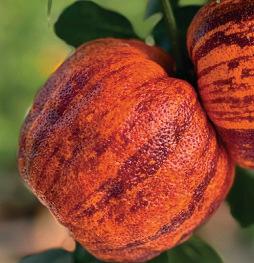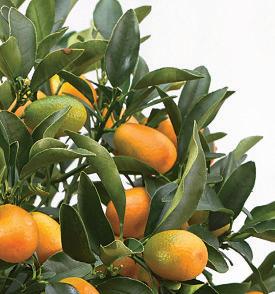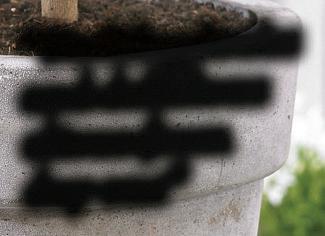
























































In the garden this month Stephanie Hafferty is earthing up potatoes, providing water for wildlife and planting runner beans 14
Catch up on the latest news, events and advice from the worldofkitchen gardening 16











KG readers sharetheir experiences andoffer their top tips for better crops 18
Our team of experts answer your urgent gardening questions
We
We visit KG reader,Peter Dean, who has been verybusy on hisplotthismonth 97
Highlightsand
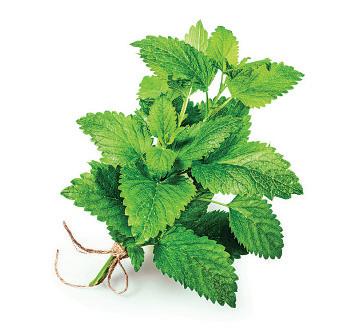




12 ON THE PLOT WITH THE THREE MUDKETEERS
Join the team in their gardens as they sow sunflowers, weed garlic and harvest chicory
30 PRICKING OUT ANDPOTTING UP! ✪
Gardening expert Martin Fish offerspractical advice on two essential garden tasks
33 BEYOND THE PLOT… BEETROOT ✪
Seed guardian Rob Smith looksatdifferent ways of preserving your harvests
37 CLIMBING HIGH ✪
Benedict Vanheems offers some growing advice to get your best harvestofclimbing beans
42 GROWING VEG AND GROWING COMMUNITY
We talk to Tanya Bowman who has helped grow agarden enterprise that involves local people in Devon
46 PROTECTING PLANTHERITAGE
Experts at Garden Organic share their experience of lookingafter National Plant Collections
50 THE VEG-GROWINGVETERANS
Sally Cliffordvisits aveterans’ allotment providing therapeutic benefitswhile growing produce
53 GROW FLAVOURSOME FENNEL
Tips on growing this tasty but also attractive crop




Delicious recipes featuring radish, purslane and peas Pg 92
54 FOOD FOR THE IMPATIENT ✪
Garden Organic’sAnton Rosenfeldshares some tips for quickand easy windowsill greens
58 GROW ATASTE THAT’S UNFORGETTABLE ✪
KG Deputy EditorEmma Rawlingslooksat growing delicious melons
61 KEEPING BEES –A BEGINNER’S GUIDE ✪
Beekeeper and founder of Buzz Box
Mark Meadows introduces the world of beekeeping for alltoenjoy
64 OUR FRIEND THE WASP
Becky Searle explains howwasps arenot our foe but of great benefittogardeners
68 SUPERFAST STRAWBERRIES ✪
Strawberries areeasy to grow and can be planted nowready for cropping in just60 days
70 SLUGS AND SNAILS AND OLD WIVES’ TALES ✪
In this extract from his book The Good Slug Guide Jo Kirby casts doubtonwho really arethe natural predators of slugs
72 HERB OF THE MONTH
This month we look at the lovely,scented lemon balm
75 IT’S APLUM JOB ✪
Fruit expertDavidPatch explains when to prune aplumtreeand experiments with growing one as acordon
Scan this,and we’lltellyou!

79 PRODUCT REVIEWS
This month we look at bags and caddies to carry smalltools
82 YOUR FREESEEDS
Some growing tips for your free gifts of kale, carrot and lettuce
84 MONEY-SAVING OFFERS ✪
Claim 20% offbeetroot and bean seeds and special offers on pots and compost
86 GIVEAWAYSWORTH OVER £878
Win prizes including pruning tools, herb collections and acordless vaccum
87 GIVEAWAY COUPON PLUS SEED SUPPLIERS
90 GARDENSTORE PLUS SUBSCRIBERSAVERS
Achance for KG subscribers to take advantage of some exclusiveoffers!



Keep hoeing on fine days to help the plot remain weed free. It’sfine to leave weeds on the surface of the soil during sunny weather as they will die and naturallybeincorporated into the soil by the soil life
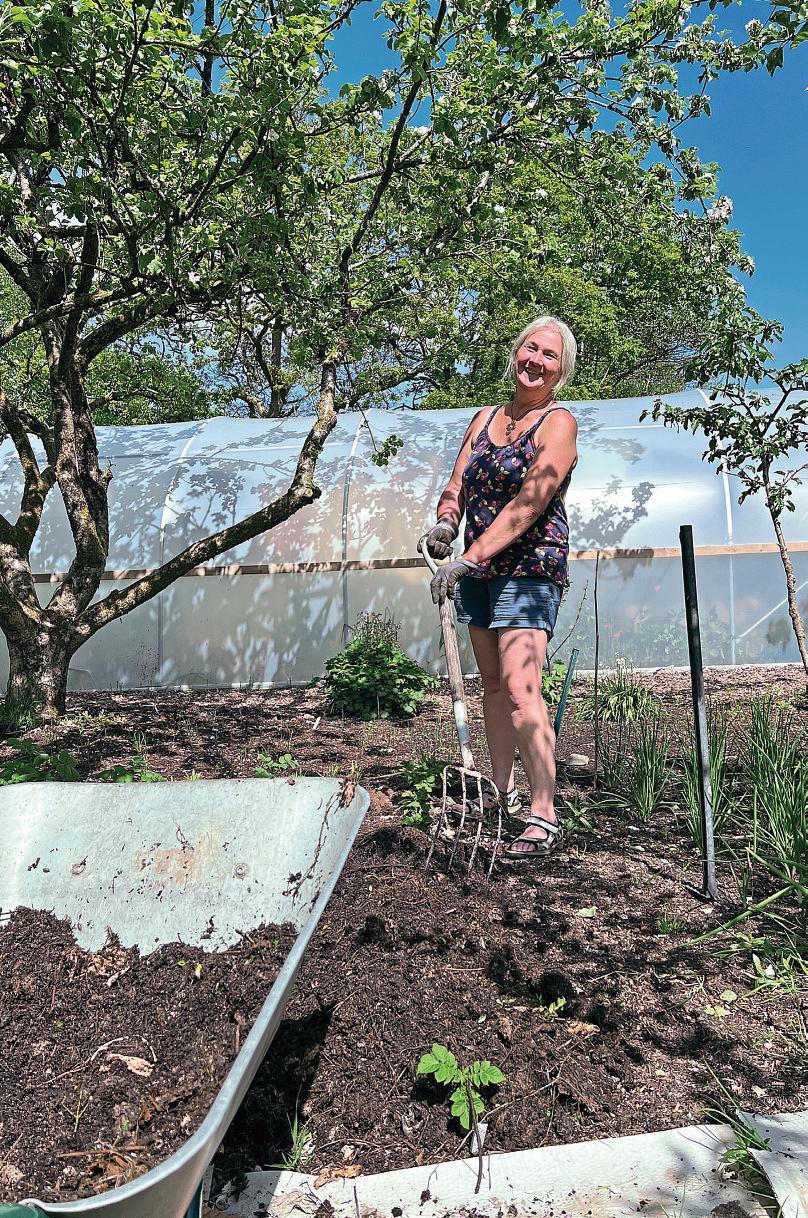
To help protect them from windy weather either push twiggy sticks near each plant or place sticks at the end of the rows and use string to create a supporting framework
Carrots can be protected from carrot root fly by covering them with alayer of fineinsect mesh. Ensure this is securely pegged down so that the flies can’tget underneath
Successional sow salad leaves every few weeks to ensureregular harvests throughout the summer without becoming overwhelmed by a lettuce glut
April planted potatoes willbesprouting green foliage now, so it is time to earth them up. Earthing up means to cover the potato stems with soil, compost or other mulches. This protects the frost sensitive plants from damage from late frosts, and also helps to prevent light reaching the tubers and turning them green. Green potatoes arenot good to eat.
Either carefully rake soilupfromthe surrounding bed over the potatoes, or add an extra layer of mulchsuchashomemade compost on top. Compost mulches also act as an additional feed for the potatoes, helping to ensureabountiful harvest. Repeat earthing up in afew weeks to be surethat all the tubers remainwell covered. If the weather is hot and dry grass clippings or straw make an excellent mulch for potatoes, helping to lock in moistureand reducing the need to water.
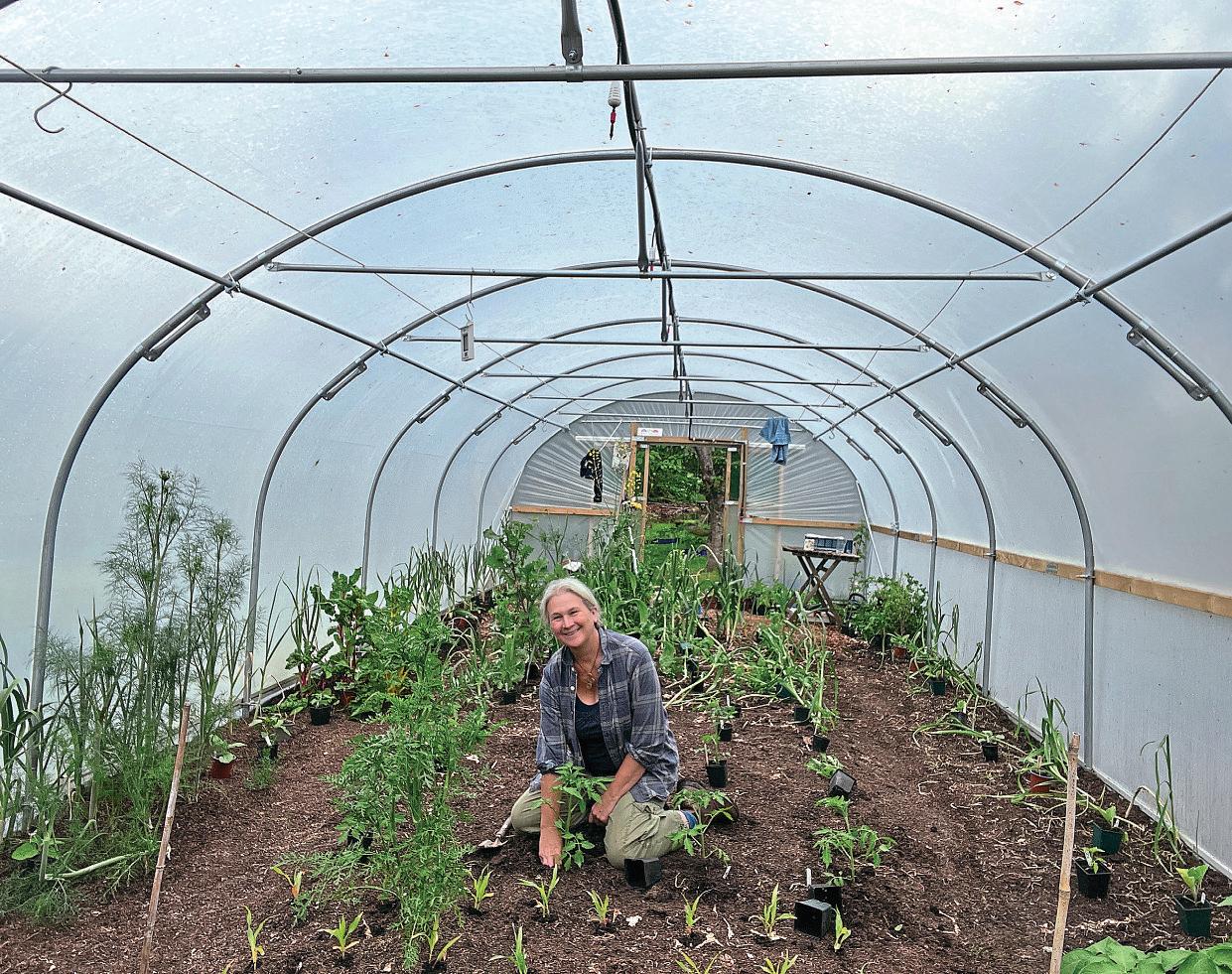
Finally,itistime to plant out all of the tendersummer crops into the polytunnel or greenhouse. Weeks of tenderly nurturing tomatoes, melons, cucumbers, aubergines, chillies and other frost-sensitive edibles means thereare trays filled with healthy looking potted plants, all ready togointo the ground or larger pots.
Beforeplanting lift any remaining overwintering crops that have finished, remove weeds and mulch the beds with some compost.
Ialways lay out the pots in the polytunnel first. In this way Ican make sure that everything is correctly spaced and will fit in. This gives me achance to rearrange things beforeplanting commences. When the main plants areinIinterplant them with basil, edible flowers and shiso to makethe most of the growing space.

Thereare two mainadvantages to growing your own sweetcorn. One is that you can pick yellow cobs at theirfreshest and cook quickly before the sugars start to turn to starch. The other is the opportunity to grow colourful heritage varieties whichare not available in shops. Thisare usually grown for popcorn or grinding into flour rather than eating on the cob.
Sweetcorn seeds arelovedbyrodents and birds, so it’sbest to sow indoors. Sow seed singly in moduletrays –loo roll tubes are ideal –filled with compost. Grow somewhere light and warm, protected from any frosts. Plant out when 10cm(4in) tall, 40cm (16in) apart in blocks. Sweetcorn is wind pollinated and pollination willbemuch better if it is grown in agroup.
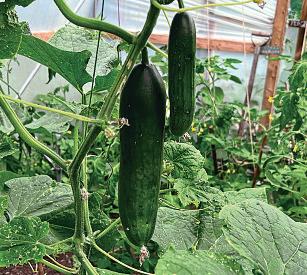
STEP 1: Cucumber is so much more than the long green-skinned fruits we see in the shops. Seed companies offer ahuge range, including yellow cucumbers resembling lemons, small ones for pickling and female flowering kinds, which areparthenocarpic sofruit without pollination. These arefreefrom bitterness.

STEP 2: Whether growing varieties for outdoor or under cover cropping starting cucumber seeds under cover helps to ensuresuccessful germination and healthy plants. Fill10cm (4in) pots with peat free multipurposecompost, tamp down and water.Sow one seed pushed in on itsside, 1cm (½in) deep in the centreofthe pot. Place somewherewarm to germinate.
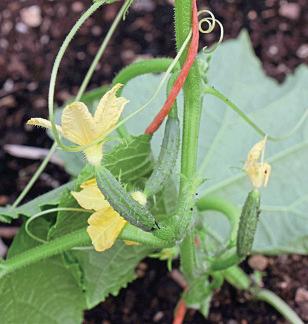
STEP 3: Plant when night temperatures won’tbelower than 12C (53F). Place under cover,growupstring or tie to long canes. Outdoors, create aframe using long sticks or grow up atrellis or similar structureattached to awall. Feed every two weeks, pinching out side shoots just beyond the female flower (the baby cucumber).

Boost your supplies of woody herbs by taking cuttings. This is asimple way to propagate plants to fillaherb garden almost for free. Fill pots with agrittycompost mix, tamp down and water.Cut 10cm (4in) long shoots from the herbs and removethe lower leaves. Cut just below aleaf joint and place into the pot around the edges. Placesix shoots in
each pot.Label and place aplasticbag over the top, securing with string or an elastic band. Keep in awarm, light place suchasa greenhouse. Rooting shouldoccurinabout eight weeks. Then, pot on each shoot into individual pots to grow on.
Herbs to try include rosemary,lemon verbena, lavender and sage.
■ Harden offunder cover grown plants so that they become used to the cooler temperatures outside beforeplanting. Take the plants outside in the morning and bring back under cover in the evening. Aways place them somewhere sheltered, out of strong winds, and make surethat they do not dry out if the weather is hot. Hardening offdoes not make plants frost hardy,sodonot plant out frost sensitive plants until the last frosts have passed.
■ Alternatively, using horticultural fleece over hardier plants such as broad beans, salads, spring onions or brassicas when planting out means that you do not need to harden off. Place the fleece over the transplants oncethey have been watered in and leave in situ for two weeks. Remove the fleece in the daytime if the weather is hot.
■ On warm, damp nights go out collecting slugs and snails to reduce the population in your plot. Relocate to awild area. If nocturnal slug forays arenot possibleplace aplank of wood near the veg beds. Thisacts as ahabitat for slugs. In the morning, turn over the plank and pick offthe slimy residents beneath.
■ Keep harvesting rhubarb, removing the toxic leaves –itisfine to compost them. During hot spellsrhubarb may start to produce aflowering stem. Twist this out and compost. Make surethat the rhubarb is well fed and watered to reduce the risk of bolting.
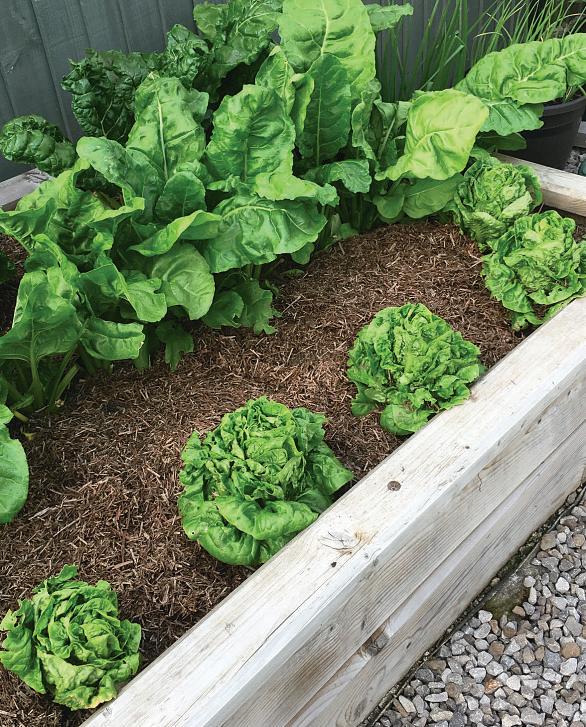
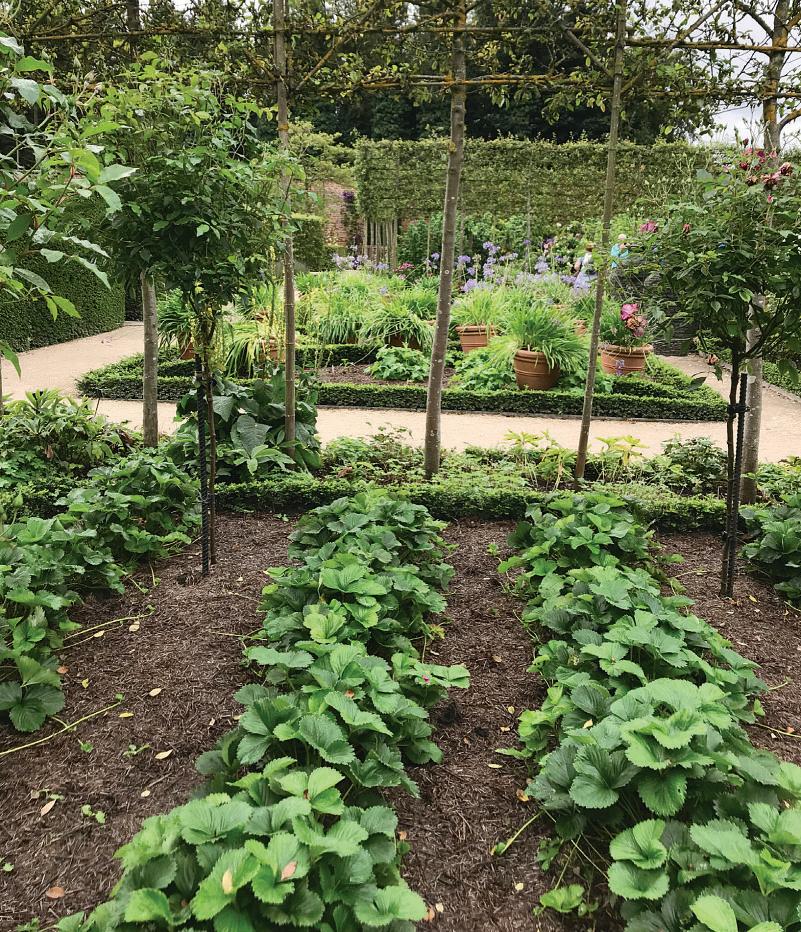















“God























made rainy days so gardeners could get the housework










“Have you viewed us on YouTube yet?”



done”





















(Anonymous)



































Steve grew lots of kale last yearincluding his favourite ‘NerodiToscana’, which he loves for its deep, earthy tasteand attractive crinkled leaves. This biennial plant flowers early in its second yearand if you wish you canlet afew plantsbloom and set seeds for use next year.However, Steve decided to cut his while the buds werestill tight shut and use them in the same way as purple sprouting broccoli. He did the same with some kalettes which had finished cropping and then produced heads of tasty buds.



Tony has been down on his knees again, this time weeding between the garlic he planted last November.There have been quite afew hardfrosts throughout March which will help in bulb formation and hopefully result in larger clovesonmaturity –aprocess known as vernalization. Now that spring has sprung he needs to cleanup the bed and watch theplants flourish. The foliage is already perking up!

Emma loves sunflowers, so likes to grow them and dot them in groups about the plot. This year she is also growing some dwarf ones and is sowing apacket of mixed colours. These include the usual yellow but also deep redand cream.Hopefully these may producesome cut flowers. They arestarted offincelltrays with small cells roughly 2.5cm (1in) in diameter.They are planted out when about 13cm (5in) tall to give them abetter chanceagainst slugs, which arepartial to sunflower seedlings.







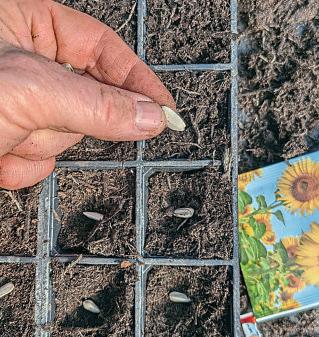































































































In late Julyand August last year Isowed some late season crops including achicorycalled ‘Variegato di Castelfranco’








(Sarah Raven seeds). Having grown steadily both indoors and out all winter (it is very hardy), plants wereready forharvesting from April and we arestill enjoying the last of the tangy leaves now, just as the tomatoes arenearly ready to take their place under cover.
The plants werea little variable, with some forming tight, beautifully variegated heads and others loose and with fewer maroon splashes, butall were delicious.Ilove it in a mixed green saladwhereits slight bitterness really steps up the flavour.Olderleaves are morebitter than the inner,blanched ones, and next year I’ll experimentwith covering (blanching)a fewofthe smaller plants for a week or two prior to harvesting in latewinter/ early spring to seeifthismakes them sweeter
Youcan sowthese seeds from May to July





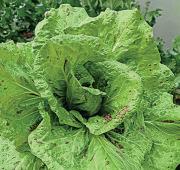









Basil is such agreat crop to grow in small potson your windowsill or in the greenhouse. Ithought Iwould grow two different ones together in thesame pot. I sprinkledabout 10 seeds of lemon basil and 10 seeds of redbasil in a9cm (3½in) pot. The lemon basil has quite ayellow leaf, so the contrast should be quite striking. I thought this would make an attractive potofleaves forthe kitchen windowsill and be useful atthe same time, offering two different leafcolours for garnishing and adding tomycooking.
The broad beans aredoing well so far.Istarted these in February in deep troughs and Ihaveto say the roots on them when Icame to plantthem werefantastic. Igrew some in cell trays too but the roots on these –although they will be fine –werenot as good. So, in future–and this goes for runners andFrench beans too –I’m going to do the same. Ithink theremust be around 50 plants, not that I’ve countedthem, working on that good old garden principle, ‘grow what you like to eat!’ Thereare three varietiesinall: ‘Vroma’, ‘Suprifin’(both new beans on the block) and an old favourite, ‘De Monica’.

















Hi! I’m Belle and I’m hereevery month to share lots of fun activities for you to do at home, on your own or with your family






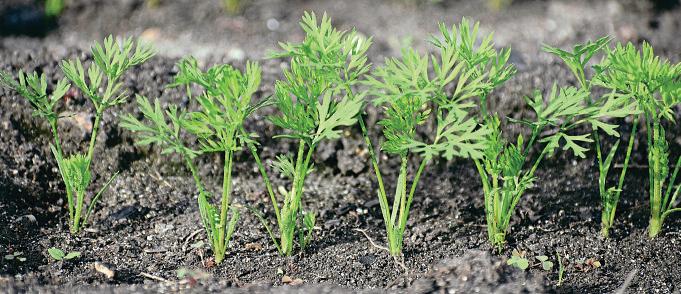



Ilove growing and eating carrots! Carrots arerootvegetables, whichmeans that they grow under the soil until you decideit’s time to digthem up. Youcan grow orange varieties like yousee in the shops, or yellow or purple ones whichare super exciting.
YOU WILL NEED:
■ Carrot seeds –you can choose from a varietyofdifferent types; long or short and round, whichever aresuitablefor your growing spot
■ Multi-purpose compost
■ A30cm potorlarger deep circular container with holes in the base. Youcan chooseacontainer as instructed or sow them straight into the ground
■ Water in awatering can
WHATTODO:
1. Fill up your container with the compost, leaving a5cm gap at the top.
2. Sprinkle your carrot seeds into the pot, leaving space between each seed for them to grow
3. Cover your seeds with a1cm thinlayer of compost.
4. Water the compost and seeds using your watering can.
5. Place your potoutside in asunny spot and very soon your seeds will start to grow.
6. Keep checking the container every day. If the soil feels dry,give it morewater
7. As your plants grow youwillstart to see the carrots forming justbelowthe surface.
8. Your carrots areready to harvest and eat as soon as they look large enough to use. This is usually between 12-16 weeks after sowing.

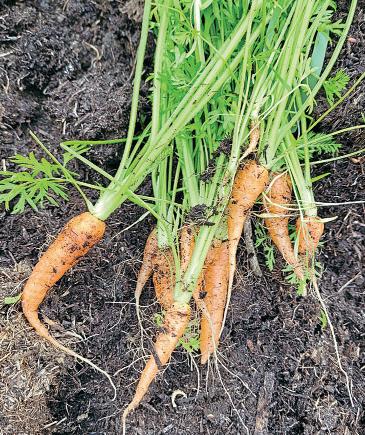






Sweet pea grower English Sweet Peas is set to make its RHS Chelsea Flower Show debut in May with avery special new launch: Sweet Pea ‘Amy Dowden’. English Sweet Peas is run by self-confessed sweet pea fanatic Phil Johnson, who has been growing sweet peas for 50 years.
Phil is hoping this new variety will receive a‘10’ from the RHS Chelsea judges as well as visitors to the show,with
the plant’slarge frilly petals of soft rose pink on awhite ground and its sweet scent. Named after ballroom dancer Amy Dowden MBE, thisvariety not only flowersover along period in the summer but is also unusual in that it regularly bears at least fiveflowers on each stem,wheremost varieties only have up to four.
The seeds of this special varietywill be available for people tobuy at the show with 10% of the sales being donated to help support Amy Dowden’stwo personally
Astudy led by DurhamUniversity has revealed that babies respond positively to foods they wereexposed to in thewomb. Using an analysis of facial expressions, researchers found that babies responded favourably to the smell of carrot wheremothershad takenpowdered carrot capsules during pregnancy,and the same effect with powdered kale capsules.
Research co-lead author Professor Nadja Reissland said: “Our analysis of the babies’ facial expressions suggests that they appear to react more favourably towards the smell of foods their mothers ate during the last months of pregnancy.Potentiallythis means we could encourage babies toreact more positively towards green vegetables, for example, by exposing them to these foods during pregnancy.”



charities: CoppaFeel, the breast cancer awareness charity,and Crohn’s&Colitis UK. Seeds can also purchased at the end of May from: www.englishsweetpeas.co.uk





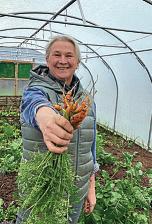



The Royal Horticultural Society (RHS) and The WildlifeTrusts are calling on gardeners across the country to helpsave hoverflies. Hoverflies visit 72% of cropsglobally, which they either pollinate or protect by eating sapsucking aphids. Additionally, they pollinate wildflowers, arefood for birdsand even help break down organic matter in gardens. However,intensive agriculture, harmful pesticides, urban development and climate change have all taken their toll. Hoverfly distribution has seen a44% decline between 1980 to 2020 and in 2022 theInternational Union for the Conservation of Natureadded hoverflies to itsRed List of threatened species.
Vicki Hird, authorofRebugging the Planet and strategicagricultureleadfor The Wildlife Trusts, says: “Hoverflies arethe hidden heroes of our gardens and countryside –but
Congratulations to regular KG contributors Stephanie Hafferty and Becky Searle, who have been listed among the top 100 Leading Women in Horticulture2025 by the horticultural news platform HortNews.
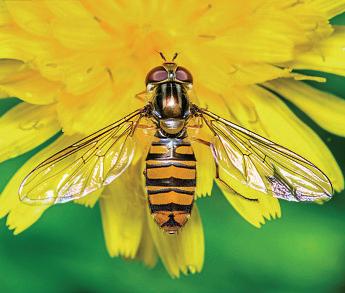
whatever their shape, size or disguise, they arecritical for our food security.Provide a range of flowers to feed on through the year, ponds for larvae to grow in, dead wood to lay eggs in and even afew aphid pests for them to feed on and youwill have these gardeners’ friends for life.”

















Last summer Iexperimented with not killing everycabbage white caterpillar that found our brassicas so enticing.We left them to munch away on afew chosen ones, hoping that in doing so the emerging butterflies would act as food source for the birds who werehavingquite ahardtimelast year because of the weather.Being pesticide free is very important on many levels. As you can see, the brassicas came in for abit of abeating –but –a few weeks later,and being the resilient plants they are,they started to grow again. Andhereweare (March atthe time of writing) and we arestill pickingkale,purple sprouting broccoli and ayesterday the last cabbage, which just goes to prove working with naturerather than against it hasnever been so important Jacci Gooding, Warwickshire
TONYSAYS: Looks like awin win win, Jacci. Birds, caterpillarsand indeed your good selves too all had apiece of the brassicapie!
Iamconstantly hearing reports of polytunnels being badlydamaged, alot of the time when the wind is not exceptionallystrong. In most cases this could be avoided by putting them up correctly.Iamnot referring to the clear topend tunnels (which areexcellent) but to the green budget tunnels. This must cost gardeners afortune. But my son and Ihave erected many of these tunnels and they do not budge. A ‘how to’video is viewableonmy YouTube video page at the very top: www.strawbaleveg.co.uk/ simons-videos Simon Gibbins, Waddington


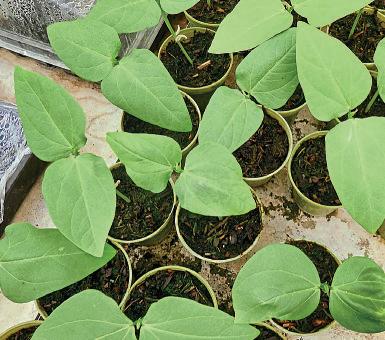

BERYL: My French beansinthe greenhouseare getting so tall now,about 9-12 inches. They have their long curly bits which need supporting.The days arenot too bad hereonthe south coast but the nights arestill chilly.DoI risk planting out or not?
MONIKA: Ihaven’teven sown my dwarforrunner beans yet because inprevious years Ihavealways been in the same quandary as you, Beryl, so this time Ihave been really firmwith myselfand will be waiting for abit.
PAWTY: Idon’tlive far from you and wouldn’t dare put French beans out untillateMay/June I’m afraid. After having lost so many now Idon’teven start mine offunder cover untilearlyMay



EDITORIAL
Tel07738 455014, Fax 01507 371075
EDITOR: Steve Ott, sott@mortons.co.uk
DEPUTY EDITOR: Emma Rawlings, erawlings@mortons.co.uk
STAFF WRITER: Tony Flanagan, tflanagan@mortons.co.uk
PRODUCTION: Sue North
PUBLISHER: Tim Hartley
DESIGNER: Charlotte Fairman
ADVERTISING
Tel01507 529529, Fax 01507 529499
GROUP ADVERTISING MANAGER: Sue Keily,skeily@mortons.co.uk
ADVERTISING TEAM LEADER: Tania Shaw,tshaw@mortons.co.uk
ADVERTISING: Mason Ponti -mason@talk-media.uk –01732 920499 Karen Davies -karen@talk-media.uk -01732 442144
SALES AND DISTRIBUTION MANAGER: Carl Smith
HEAD OF MARKETING: Charlotte Park
PUBLISHING DIRECTOR: Dan Savage
COMMERCIAL DIRECTOR: Nigel Hole
GENERAL QUERIES AND BACK ISSUES Customer Service: Tel01507 529529 Telephone lines areopen: Monday-Friday 8.30am-5pm 24hr answerphone help@classicmagazines.co.uk www.classicmagazines.co.uk
ARCHIVIST: Jane Skayman, 01507 529423, jskayman@mortons.co.uk
SUBSCRIPTION: Full subscription rates (butsee page 28 for offer): (12 months 12 issues, incpost and packing) –UK£83.88. Export rates arealso available –see page 28 for moredetails. UK subscriptions arezero-ratedfor the purposes of Value Added Tax.
DISTRIBUTION
Seymour Distribution Ltd, 2East Poultry Avenue, London, EC1A 9PT.Tel 0207429 4000
PRINTING William Gibbons &Sons, Wolverhampton
PUBLISHED Monthly by Kelsey Media Ltd, The Granary,Downs Court, Yalding Hill, Yalding, Maidstone, Kent ME186AL Tel01507 523456, Fax 01507 529301 THE TALKING KG Kitchen Garden is available on audio CD or USB at very reasonable rates to anyoneunable to read normal type. Details from theTalking Newspaper Association of the UK on 01435 866102. ISSN 1369-1821
©Copyright Kelsey Media Ltd. Reproduction in any manner,inwhole or part, without prior approval in writing is prohibited. The publisher cannot accept responsibility for errors in articlesoradvertisements, or for unsolicited manuscripts, photographsor illustrations. www.kitchengarden.co.uk
ADVERTDEADLINE: May6,2025 NEXT ISSUE:



Ihave grown tomatoes in my greenhouse anumber of times but they always have athick skin.What am Idoing wrong?
Jim Torrance, Galashiels







are more naturally too thick and to eat is to the plants (and
STEVE SAYS: Some varieties aremorenaturally thick-skinned than others, but the key topreventing them from becoming too thick and unpleasant to eat is to keep theplants(and thereforethe fruit) growing reasonably quicklyand without growthchecks.
Last summer was quite aslow year for tomatoes Ifound, mainly due to alack of sunny days at times and, of course, thereisn’tmuch you can do about that. However,inanormal season it’smaking surethe plantshave plenty of water–they should never wilt but always have enough to allow them to keep growing and swelling the fruit. Even, regular watering will also help to minimise fruit splitting.
It is also very important tofeed regularly with aliquid tomatofood either once aweek, or at half strength every watering. Tomato foods will contain all the plantsneed to develop the fruit as well as to grow healthy leaves and stems.





Star Question winners receive a voucher worth £25, and £10each for the others. These can be redeemedagainst any products in the latest Mr Fothergill’s range, which can be viewedonline by visiti www.mr-fothergills.co.uk. Email questions to tflanagan@mortons.co.uk or post to Question Time, Kitchen Garden,Kelsey Publishing Ltd, MediaCentre, Morton Wa Horncastle, Lincs LN9 6JR. Please include your full address on letters and emails range, which can viewed online visiting Email Ltd, Media Centre, Way, Horncastle, Please include


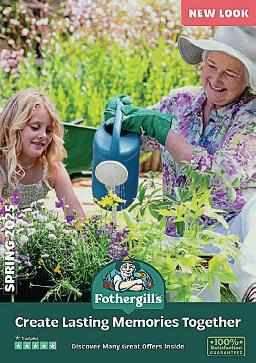
I’ve chosen to try onions from seed this year alongside the sets. The germination has gone well. Can you advise on when to transplant and should this be in to plant potsor directly into pre-prepared soil?


Steve Watkin, Co Durham
EMMA SAYS: Youhave sown nice andevenly and it looks like theyoung seedlings have space to grow,soIwould leave them in the troughs until well established. That is until the growth becomes upright and the individual‘stems’
have thickened up enough to be selfsupporting.
Then, beforethey become overcrowded, move them on into individual cellsorsmall (7cm/3in) pots to grow on. Harden them offgradually by moving them outside during the day (avoid having them outside during very windy weather,orpop them into acold frame for protection) and by the end of April/earlyMay they shouldbeabout ready toplant out into their cropping positions.
For large bulbsspacing is usually about 10cm (4in) apart and with 25cm (10in) between rows.

We have two compostersand all the relevant stuffgoes in there, supplying our garden with the material it needsto thrive.However,much of the veg was purchased from supermarkets and all those have been sprayed by insecticides in the food production industry.They may have been sprayed withforever chemicals. So what arethe chances that my garden is, in fact,organic?
Beverley Ward,Eastbourne


ANTON SAYS: the is it
ANTON SAYS: If you are asking the question is it possible to guarantee that your garden is completely free of contaminants
contaminants
then, unfortunately, the answer is likely to be no. In commercial agriculture if afarm wishes to convert to organic production it has to allow atwo-year conversion periodbut theremay well still be traces of chemicals leftafter then. In many cases the effects can be pretty negligiblebut sometimes we later discover thatthings have muchmore persistent effects than we first thought. Neonicotinoids are an example –just miniscule amounts can have pretty damaging effects. Alot of it boils down to making balanced decisions –itmakes moresense to put anon-organicbanana skin in your home compost than put it in your bin to be transported away.




I’m tempted to get strawberry ‘Summer Breeze’ as the redflowers look vibrant before fruiting. But as it’sanF1variety does that mean the next generation of baby plants willgoback to being white flowered?
Janice Sharkey,Glasgow


TONY SAYS:
TONY SAYS: The plants you purchase will always produce pink flowers. However, as an F1, hybrid seeds from those plants will not come true to type.‘Summer eeze’ does producesome runners, not prolifically,but enough to propagate afew as youneed them –and new plants grown from these will be identical to the parent, giving you the lovelypink blooms.
not come true to type. ‘Summer Breeze’ does produce some runners,



